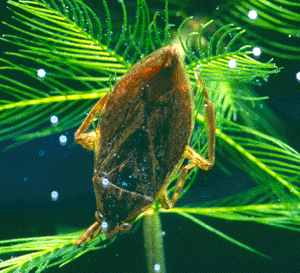Giant Water Beetles
 These beetles hang out on vegetation, waiting to pounce on their prey: small fish, tadpoles, insects, snails, and macroinvertebrates. They consume their prey in much the same way that predaceous diving beetles do.
These beetles hang out on vegetation, waiting to pounce on their prey: small fish, tadpoles, insects, snails, and macroinvertebrates. They consume their prey in much the same way that predaceous diving beetles do.
Giant Water Beetles have wings and often leave the water to fly about, you may even see them near lights on a summer night!
